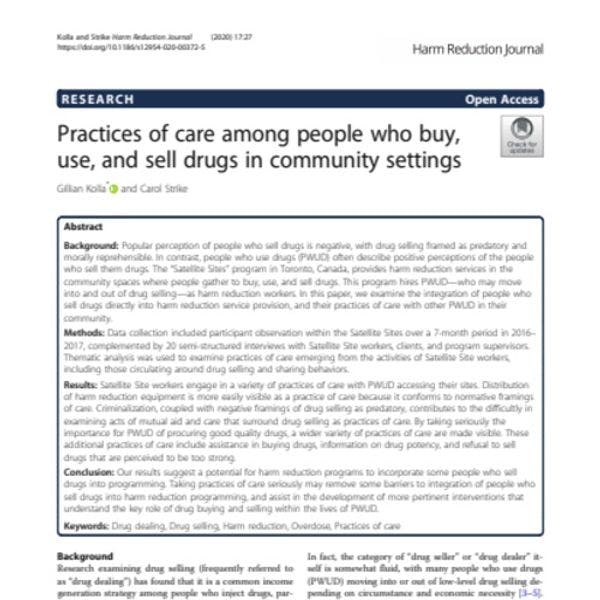Prácticas de atención entre personas que compran, consumen y venden drogas en entornos comunitarios
Kolla y Strike subrayan el potencial para la reducción de daños de incluir en los programas a algunas personas que venden drogas. Más información, en inglés, está disponible abajo.
By Gillian Kolla and Carol Strike / The Harm Reduction Journal
Abstract
Popular perception of people who sell drugs is negative, with drug selling framed as predatory and morally reprehensible. In contrast, people who use drugs (PWUD) often describe positive perceptions of the people who sell them drugs. The “Satellite Sites” program in Toronto, Canada, provides harm reduction services in the community spaces where people gather to buy, use, and sell drugs. This program hires PWUD—who may move into and out of drug selling—as harm reduction workers. In this paper, we examine the integration of people who sell drugs directly into harm reduction service provision, and their practices of care with other PWUD in their community.
Data collection included participant observation within the Satellite Sites over a 7-month period in 2016–2017, complemented by 20 semi-structured interviews with Satellite Site workers, clients, and program supervisors. Thematic analysis was used to examine practices of care emerging from the activities of Satellite Site workers, including those circulating around drug selling and sharing behaviors.
Satellite Site workers engage in a variety of practices of care with PWUD accessing their sites. Distribution of harm reduction equipment is more easily visible as a practice of care because it conforms to normative framings of care. Criminalization, coupled with negative framings of drug selling as predatory, contributes to the difficultly in examining acts of mutual aid and care that surround drug selling as practices of care. By taking seriously the importance for PWUD of procuring good quality drugs, a wider variety of practices of care are made visible. These additional practices of care include assistance in buying drugs, information on drug potency, and refusal to sell drugs that are perceived to be too strong.
Our results suggest a potential for harm reduction programs to incorporate some people who sell drugs into programming. Taking practices of care seriously may remove some barriers to integration of people who sell drugs into harm reduction programming, and assist in the development of more pertinent interventions that understand the key role of drug buying and selling within the lives of PWUD.
